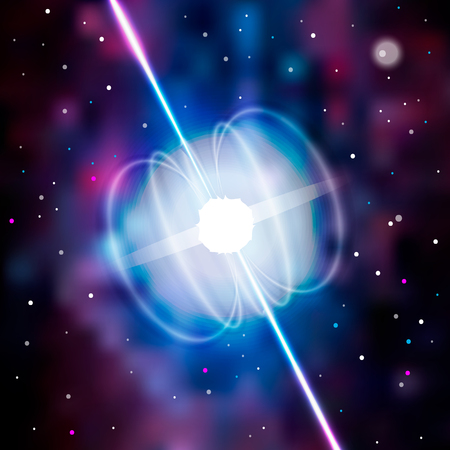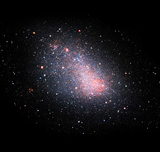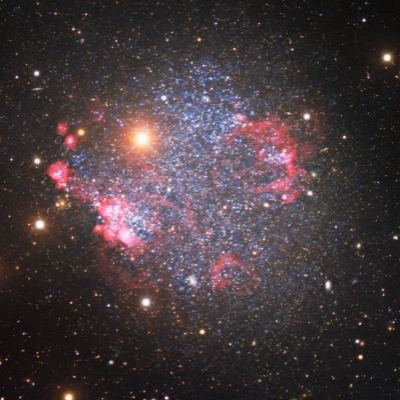Research
I am a radio astronomer who works on pulsars, an uncommon type of star with unique physical properties.
 Pulsars
—
A pulsar is a type of neutron star. These collapsed stars are amongst the most extreme objects of the Universe - they are the fastest spinning stars (usually, they undergo one complete revolution in less than a few seconds); they are the smallest and densest stars, with approximately the mass of our Sun contained in a radius of a few tens of kilometres; and they have the strongest stellar magnetic fields. Their lighthouse-like radio beams are observed as faint radio pulses from the Earth. I have been searching for such pulses coming from outside our galaxy in high time resolution observations made with the very sensitive MeerKAT radio telescope.
Pulsars
—
A pulsar is a type of neutron star. These collapsed stars are amongst the most extreme objects of the Universe - they are the fastest spinning stars (usually, they undergo one complete revolution in less than a few seconds); they are the smallest and densest stars, with approximately the mass of our Sun contained in a radius of a few tens of kilometres; and they have the strongest stellar magnetic fields. Their lighthouse-like radio beams are observed as faint radio pulses from the Earth. I have been searching for such pulses coming from outside our galaxy in high time resolution observations made with the very sensitive MeerKAT radio telescope.
 What can be done with pulsars?
—
Since their discovery in 1967, pulsars have been a formidable “laboratory” for many fields of science. Their pulses can be better at timekeeping than atomic clocks. Any variations in the timing of these pulses can be an indicator of astrophysical processes such as gravitational waves, companion stars with relativistic dynamics, planets, etc.
What can be done with pulsars?
—
Since their discovery in 1967, pulsars have been a formidable “laboratory” for many fields of science. Their pulses can be better at timekeeping than atomic clocks. Any variations in the timing of these pulses can be an indicator of astrophysical processes such as gravitational waves, companion stars with relativistic dynamics, planets, etc.
 MeerKAT
—
MeerKAT is located in South Africa, in the Karoo desert over an area 8km across. It is an interferometer that consists of 64 dishes, each of 14m diameter. I am part of the TRAPUM collaboration (we search for TRAnsients and PUlsars with MeerKAT). You can find our latest discoveries here! I am now also responsible for the maintenance of the MeerKAT pulsar timing data.
MeerKAT
—
MeerKAT is located in South Africa, in the Karoo desert over an area 8km across. It is an interferometer that consists of 64 dishes, each of 14m diameter. I am part of the TRAPUM collaboration (we search for TRAnsients and PUlsars with MeerKAT). You can find our latest discoveries here! I am now also responsible for the maintenance of the MeerKAT pulsar timing data.
 Discoveries in the Small Magellanic Cloud
—
I have conducted the first pulsar and Fast Radio Burst surveys of nearby galaxies with the MeerKAT telescope, the most sensitive radio telescope in the world! I have doubled the radio pulsar population of this galaxy, with seven discoveries. Using MeerKAT and the Murriyang telescope in Australia, I investigated their behaviour. I found out that three of them are "young", energetic pulsars that underwent a kind of starquake called a "glitch". I associated one of my pulsar discoveries to a known Pulsar Wind Nebula, and identified a new, rare extragalactic Pulsar Wind Nebula around another discovery. Overall, I increased the characterised population of extragalactic pulsars by 40%! [1, 2, 3]
Discoveries in the Small Magellanic Cloud
—
I have conducted the first pulsar and Fast Radio Burst surveys of nearby galaxies with the MeerKAT telescope, the most sensitive radio telescope in the world! I have doubled the radio pulsar population of this galaxy, with seven discoveries. Using MeerKAT and the Murriyang telescope in Australia, I investigated their behaviour. I found out that three of them are "young", energetic pulsars that underwent a kind of starquake called a "glitch". I associated one of my pulsar discoveries to a known Pulsar Wind Nebula, and identified a new, rare extragalactic Pulsar Wind Nebula around another discovery. Overall, I increased the characterised population of extragalactic pulsars by 40%! [1, 2, 3]
 The pulsar population of the Small Magellanic Cloud
—
In addition, by extending the extragalactic sample of known pulsars, we are effectively probing the effects of another galaxy’s properties onto a neutron star population, as a valuable contrast to the Milky Way. For example, we could understand better how galactic metallicity and star formation history affect the formation of neutron stars. This is also of interest to the Gravitational Wave and Fast Radio Burst scientific communities. [in prep!]
The pulsar population of the Small Magellanic Cloud
—
In addition, by extending the extragalactic sample of known pulsars, we are effectively probing the effects of another galaxy’s properties onto a neutron star population, as a valuable contrast to the Milky Way. For example, we could understand better how galactic metallicity and star formation history affect the formation of neutron stars. This is also of interest to the Gravitational Wave and Fast Radio Burst scientific communities. [in prep!]
 Discoveries in the Sextans A & B galaxies
—
I have discovered a Fast Radio Burst, a very energetic extragalactic signal of unknown origin, during this survey. I also set limits on the brightest possible pulsar beaming towards us from these galaxies. [4]
Discoveries in the Sextans A & B galaxies
—
I have discovered a Fast Radio Burst, a very energetic extragalactic signal of unknown origin, during this survey. I also set limits on the brightest possible pulsar beaming towards us from these galaxies. [4]
 Searching the Sagittarius Dwarf Spheroidal Galaxy
—
I have designed and helped start this challenging survey to find the furthest pulsars with millisecond periods in this gamma-ray emitting, globular cluster-rich galaxy. [in prep]
Searching the Sagittarius Dwarf Spheroidal Galaxy
—
I have designed and helped start this challenging survey to find the furthest pulsars with millisecond periods in this gamma-ray emitting, globular cluster-rich galaxy. [in prep]
